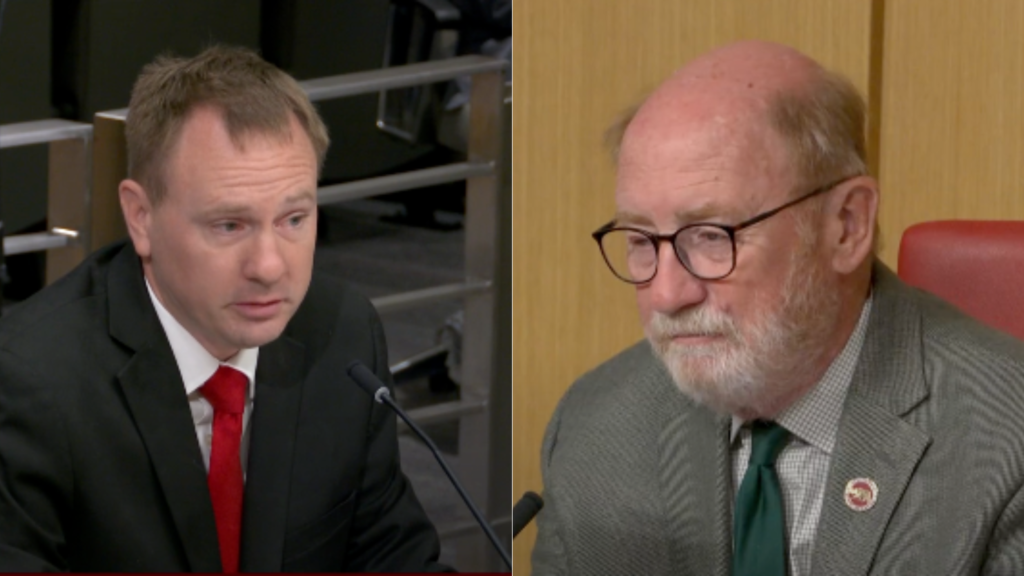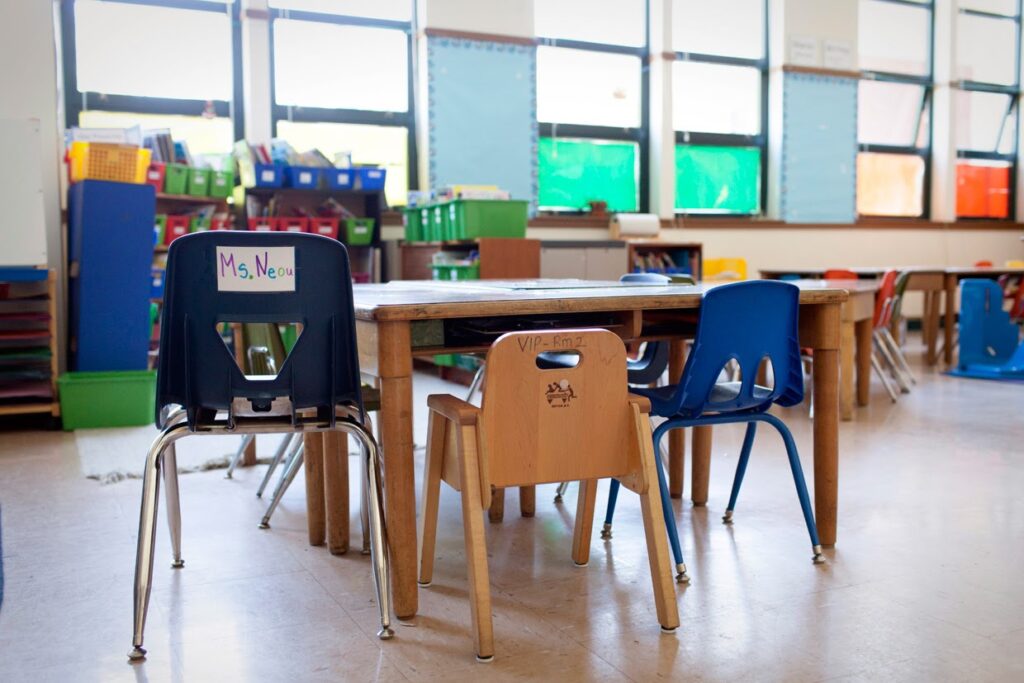
Sen. John Laird, D-Santa Cruz, right, listens as Ken Kapphahn of the Legislative Analyst’s Office critiques Gov. Gavin Newsom’s proposed education budget at a hearing on May 22.
Credit: State Senate Media Archive
Top Takeaways
- A drop in project state revenue projections from January to May, while avoiding cuts, would compound a dilemma.
- Newsom also would increase funding for early literacy and after-school programs.
- Key legislators share concern about draining the rainy day fund and deferring payments.
The Legislative Analyst’s Office is criticizing Gov. Gavin Newsom’s spending plan for next year for schools and community colleges. It says the May revision of the 2025-26 state budget would create new debt, rely on one-time funding to pay for ongoing operations, and drain the education rainy day fund to pay for new programs and enlarge existing ones.
The Legislature should reject the financially unsound practices, which would “put the state and districts behind the eight ball” if state revenues fall short of projections, Ken Kapphahn, senior fiscal and policy analyst for the LAO, told the Legislature’s budget committees on May 22.
The LAO provides the Legislature with nonpartisan analysis and advice on fiscal and policy issues.
In his budget for 2025-26, Newsom would protect TK-12 and community colleges from a $4.4 billion drop in projected state revenue between his January and revised May budgets and add $2 billion in spending to the administration’s priorities, which include:
- Qualifying more students for coverage of summer and after-school learning through the Expanded Learning Opportunities Program ($526 million).
- Hiring more math and literacy coaches and training teachers in literacy instruction ($745 million). The money would reflect legislation that the Legislature is expected to pass requiring textbooks and instruction practices to incorporate phonics and foundational skills.
- Reducing the student-to-staff ratio in transitional kindergarten from 12 to 1 to 10 to 1 ($517 million).
- Paying stipends for student teachers ($100 million).
The biggest budget challenge is that the projected Proposition 98 guarantee for 2025-26 — the minimum portion of the state’s General Fund that must be spent on TK-12 and community colleges — fell $4.4 billion — from $118.9 billion in the initial budget in January to $114.5 billion in May — because of revised revenue forecasts for California that project a drop in stock market earnings and uncertain impacts from President Donald Trump’s economic policies.
Newsom’s May budget would include some cuts and savings from, for example, lower projected enrollment in transitional kindergarten. It would also withdraw or reduce nearly $400 million in community college funding for updating data systems and investing in Newsom’s Master Plan for Career Education (see Page 28 of his budget summary).
But he’d primarily rely on financial tactics that the LAO cited as fiscally risky and unwise:
- Committing $1.6 billion in one-time funding for ongoing funding, a strategy that could leave the state short of funding starting a year from now;
- Depleting the Prop. 98 rainy day fund by $1.5 billion;
- Issuing a $2.3 billion IOU by pushing back paying $1.8 billion for TK-12 and $532 million for community colleges from June 2026 to the next fiscal year in 2026-27. This deferral, though only for several weeks, creates a debt that must be repaid. Paying it off will eat into state revenue for districts and community colleges in the subsequent year.
Issuing deferrals and digging into the state’s reserves have been done before during recessions and financial emergencies, but should be viewed as “a tool of last resort,” not as solutions to difficult spending choices, Kapphahn said.
“The state historically has tried to contain spending during tight times to protect funding for core programs,” its critique said. “May Revision would task districts with hiring staff and expanding local programs based on funding levels that the state might be unable to sustain.”
Neither LAO nor Newsom is predicting a financial recession, but both project weakened state revenues over the next two years.
The LAO’s option
The LAO put forward an alternative budget that it claims would meet the revised, lower Prop. 98 minimum funding guarantee for 2025-26, including a required 2.3% cost-of-living adjustment for community colleges and schools. It would avoid deferrals, reduce $1.6 billion in ongoing spending, and reject many of Newsom’s one-time spending proposals, including literacy training and materials.
Instead, consistent with local control, it would increase an existing discretionary block grant to let districts choose how to spend much less new money.
Negotiations in the coming weeks between Newsom and legislative leaders will determine what’s in the final budget. However, two Democratic leaders who chair budget committees overseeing education in the Assembly and Senate said they shared the LAO’s skepticism.
Sen. John Laird, D-Santa Cruz, said he felt uncomfortable recommending increased funding for individual programs that “set us on for being in trouble next year.”
“If we do all this, and the projections are accurate,” he said at the May 22 hearing, “there will not be enough money to pay off deferrals and make the COLA. The decision to put us in that position we are making now, potentially creating a bad situation for next year.”
Assemblymember David Alvarez, D-San Diego, who chairs the Assembly Budget Subcommittee on Education Finance, said he too is concerned that the proposed budget would deplete the last $1.5 billion of the rainy day fund, which was $8.4 billion only two years ago.
At the same time, he agrees with Newsom’s new spending on literacy instruction and funding for stipends for student teachers. And he would add in money for ethnic studies that Newsom didn’t include. Without the funding, the mandate for a semester-long ethnic studies course that the Legislature required, starting in 2025-26, cannot take effect.
Alvarez didn’t suggest budget cuts to make room for ethnic studies.




